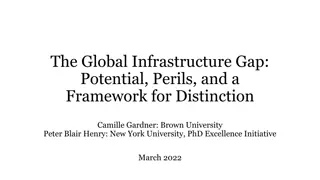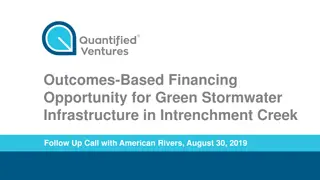Green Infrastructure Framework: Principles and Standards for England
Green Infrastructure is a network of green and blue spaces delivering environmental, economic, health, and social benefits. The framework aims to improve and create quality green infrastructure for all, with an emphasis on access and sustainability. It includes principles, standards, mapping, planning guides, and strategies to enhance nature-rich, resilient, and prosperous communities.
Download Presentation

Please find below an Image/Link to download the presentation.
The content on the website is provided AS IS for your information and personal use only. It may not be sold, licensed, or shared on other websites without obtaining consent from the author. Download presentation by click this link. If you encounter any issues during the download, it is possible that the publisher has removed the file from their server.
E N D
Presentation Transcript
Green Infrastructure Framework - Principles and Standards for England Jane Houghton Senior Adviser, Project Manager, GI Framework, Natural England April 2023 www.gov.uk/natural-england 1
What is Green Infrastructure? Green infrastructure: A network of multi-functional green and blue spaces and other natural features, urban and rural, which is capable of delivering a wide range of environmental, economic, health and wellbeing benefits for nature, climate, local and wider communities and prosperity . Nature doing a job Healthier, more resilient Nature Healthier, more resilient Places Healthier, more resilient People Healthier, more resilient Economy
Aims Improve existing and create more good quality green infrastructure for all its benefits Everyone has access to good quality green infrastructure, particularly in areas of low income and health inequalities Support Local Authorities in refresh of local plans Mainstream Green Infrastructure as a key asset in creating and maintaining sustainable places Credit: Julia Thrift Will replace 3
Green Infrastructure Framework Green Infrastructure Principles Green Infrastructure Mapping V1.2 UPDATED Headline Green Infrastructure Standards Green Infrastructure Planning and Design Guide Process Journeys NEW 4
Green Infrastructure Principles Why? Nature rich beautiful places Active and healthy people and places Thriving & prosperous communities Climate resilient places Improved water management www.gov.uk/natural-england 5
5 Headline Green Infrastructure Standards 1. Green Infrastructure Strategy Standard 2. Accessible Greenspace Standards 3. Urban Nature Recovery Standard 4. Urban Greening Factor Standard 5. Urban Tree Canopy Cover Standard 6
Green Infrastructure Strategy Standard Headline Standard 1 Area-wide Local Authorities in partnership with local communities, produce a Green Infrastructure Strategy and Delivery Plan applying the Green Infrastructure Principles and Standards locally Manchester City Council Major development A Green Infrastructure Plan (can be part of a Design and Access Statement). 7
Accessible Greenspace Standards Headline Standard 2 Area-wide Everyone has access to good quality greenspaces within 15 minutes walk from home. At least 3 hectares per 1000 population of publicly accessible greenspace Accessible greenspace meets the Green Flag Award Criteria and best practice in accessibility for all Major development The local authority specifies the quantity, size and distance for accessible greenspace to be provided, based on the Accessible Greenspace Standards. 8
Urban Nature Recovery Standard Headline Standard 3 Area-wide In urban and urban fringe areas, green infrastructure for nature recovery is increased by an agreed % Increase in the number and quality of Local Nature Reserves and Local Wildlife Sites Major development Credit: Berkeley Group The developer identifies, in the Green Infrastructure Plan for the development (or in the Design and Access Statement), its contribution to nature recovery. 9
Urban Greening Factor Standard Headline Standard 4 Area-wide At least 40% average green cover in urban residential neighbourhoods. No net loss of green cover in urban neighbourhoods Major development Urban Greening Factors of 0.4 for residential 0.3 for commercial 0.5 for residential greenfield User Guide: Urban Greening Factor for England User Guide.pdf (naturalengland.org.uk) Photo: Peter Neal 10
Urban Greening Factor - UGF - for England UGF Core Components 1 - Target Score for Urban Greening 0.3 for predominately commercial development 0.4 for predominately residential development 0.5 for residential greenfield 2 - Weighed Surface Cover Types Vegetation and Tree Planting Green Roofs and Walls SUDS and Water features Paved Surfaces 11 Derwenthorpe, York Hammarby Sj stad, Stockholm
Calculating the UGF Score - Example of an UGF Calculation Theoretical Development Site Plan showing UGF factors Total Area 100 sqm 12
Urban Tree Canopy Cover Standard Headline Standard 5 Area-wide Urban Tree Canopy Cover is increased by an agreed percentage based on a locally defined baseline and taking into account local needs, opportunities and constraints Major Development Major development is designed to meet these targets New and existing trees are incorporated into new developments and new streets are tree lined (in line with NPPF). 13
Green Infrastructure Mapping: How it can be used https://designatedsites.naturalengland.org.uk/GreenInfrastructure/map.aspx 5 Where is the Green Infrastructure? (Standard 1) Where do gaps matter most? Who lives within 15 minutes of good quality green space? (Standard 2) How green in your neighbourhood? (Standard 4) 14
Green Infrastructure Planning and Design Guide Supports local authorities in developing design codes for green infrastructure Complements the National Design Guide and National Model Design Code Provides evidence for the functions provided by GI and practical advice for planning and designing good green infrastructure www.gov.uk/natural-england 15
Process Journeys - guides Step-by-step Guides - for different audiences to help policy making, strategy and delivery of the GI Standards at local level. For: Partnership and Vision Evidence Local Planning Authorities - developing Green Infrastructure Strategies and Policies Planning Strategically and developing GI Policy Developers and Design Teams - Incorporating Green Infrastructure into Development Integrating the GI Strategy Managing, Valuing, Monitoring and Evaluating GI Neighbourhood Planning Groups - Incorporating Green Infrastructure into Neighbourhood Plans 16
https://designatedsites.naturalengland.org.uk/GreenInfrastructure/Home.aspxhttps://designatedsites.naturalengland.org.uk/GreenInfrastructure/Home.aspx 17
Green Infrastructure Planning and Design Guide How to apply the GI Framework including: Principles (Why, What & How) Standards (GI Strategy, Accessible Greenspace, Urban Nature Recovery, Urban Greening Factor, Urban Tree Canopy Cover) Designed to work with the three-step process in National Model Design Code: Baseline analysis, Vision, Coding. Matrix showing the National Design Guide s 10 characteristics of a well- designed place, and how green infrastructure can be designed in to deliver for each characteristic. www.gov.uk/natural-england 19








 undefined
undefined


































